- Clone
- 29F.1A12 (See other available formats)
- Regulatory Status
- RUO
- Other Names
- PD-1, Programmed Death-1, PDCD1
- Isotype
- Rat IgG2a, κ
- Ave. Rating
- Submit a Review
- Product Citations
- publications
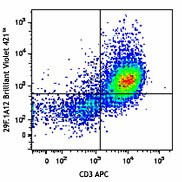
-

Con-A and IL-2 stimulated C57BL/6 splenocytes (3 days) were stained with CD3 APC and CD279 (clone 29F.1A12) Brilliant Violet 421™ (top), or rat IgG2a, κ Brilliant Violet 421™ isotype control (bottom). -

-

Mice were injected subcutaneously with sheep red blood cells in a volume of 25 µl per site on days 0 and 4 and harvested on day 11. Confocal image of C57BL/6 mouse lymph node acquired using the IBEX method of highly multiplexed antibody-based imaging: PD-1 (green) in Cycle 1, CD23 (magenta) in Cycle 7, and IgD (blue) in Cycle 10. Tissues were prepared using ~1% (vol/vol) formaldehyde and a detergent. Following fixation, samples are immersed in 30% (wt/vol) sucrose for cryoprotection. Images are courtesy of Drs. Andrea J. Radtke and Ronald N. Germain of the Center for Advanced Tissue Imaging (CAT-I) in the National Institute of Allergy and Infectious Diseases (NIAID, NIH).
CD279, also known as programmed death-1 (PD-1), is a 50-55 kD glycoprotein belonging to the CD28 family of the Ig superfamily. PD-1 is expressed on activated splenic T and B cells and thymocytes. It is induced on activated myeloid cells as well. PD-1 is involved in lymphocyte clonal selection and peripheral tolerance through binding its ligands, B7-H1 (PD-L1) and B7-DC (PD-L2). It has been reported that PD-1 and PD-L1 interactions are critical to positive selection and play a role in shaping the T cell repertoire. PD-L1 negative costimulation is essential for prolonged survival of intratesticular islet allografts.
Product DetailsProduct Details
- Verified Reactivity
- Mouse
- Antibody Type
- Monoclonal
- Host Species
- Rat
- Immunogen
- PD-1 cDNA followed by PD-1-Ig fusion protein
- Formulation
- Phosphate-buffered solution, pH 7.2, containing 0.09% sodium azide and BSA (origin USA).
- Preparation
- The antibody was purified by affinity chromatography and conjugated with Brilliant Violet 421™ under optimal conditions.
- Concentration
- µg sizes: 0.2 mg/mLµL sizes: lot-specific (to obtain lot-specific concentration and expiration, please enter the lot number in our Certificate of Analysis online tool.)
- Storage & Handling
- The antibody solution should be stored undiluted between 2°C and 8°C, and protected from prolonged exposure to light. Do not freeze.
- Application
-
FC - Quality tested
SB - Reported in the literature, not verified in house
- Recommended Usage
-
Each lot of this antibody is quality control tested by immunofluorescent staining with flow cytometric analysis. For immunofluorescent staining using the µg size, the suggested use of this reagent is ≤0.125 µg per million cells in 100 µl volume. For immunofluorescent staining using µl sizes, the suggested use of this reagent is 5 µl per million cells in 100 µl staining volume or 5 µl per 100 µl of whole blood. It is recommended that the reagent be titrated for optimal performance for each application.
Brilliant Violet 421™ excites at 405 nm and emits at 421 nm. The standard bandpass filter 450/50 nm is recommended for detection. Brilliant Violet 421™ is a trademark of Sirigen Group Ltd.
Learn more about Brilliant Violet™.
This product is subject to proprietary rights of Sirigen Inc. and is made and sold under license from Sirigen Inc. The purchase of this product conveys to the buyer a non-transferable right to use the purchased product for research purposes only. This product may not be resold or incorporated in any manner into another product for resale. Any use for therapeutics or diagnostics is strictly prohibited. This product is covered by U.S. Patent(s), pending patent applications and foreign equivalents. - Excitation Laser
-
Violet Laser (405 nm)
- Application Notes
-
Additional reported applications (for the relevant formats) include: immunohistochemical staining of acetone-fixed frozen tissue3, in vivo blocking of PD-1 binding to its ligands2,3, and spatial biology (IBEX)5,6.
- Additional Product Notes
-
Iterative Bleaching Extended multi-pleXity (IBEX) is a fluorescent imaging technique capable of highly-multiplexed spatial analysis. The method relies on cyclical bleaching of panels of fluorescent antibodies in order to image and analyze many markers over multiple cycles of staining, imaging, and, bleaching. It is a community-developed open-access method developed by the Center for Advanced Tissue Imaging (CAT-I) in the National Institute of Allergy and Infectious Diseases (NIAID, NIH).
- Application References
-
- Good-Jacobson KL, et al. 2010. Nat. Immunol. 11:535. (FC) PubMed
- Lázár-Molnár E, et al. 2008. Proc. Natl. Acad. Sci. USA 105:2658. (Block)
- Liang SC, et al. 2003. Eur. J. Immunol. 33:2706. (FC, IHC, Block)
- Tobias J, et al. 2020. Front Immunol. 11:895 (FC, ELISA) PubMed
- Radtke AJ, et al. 2020. Proc Natl Acad Sci U S A. 117:33455-65. (SB) PubMed
- Radtke AJ, et al. 2022. Nat Protoc. 17:378-401. (SB) PubMed
- Product Citations
-
- RRID
-
AB_2561447 (BioLegend Cat. No. 135217)
AB_2561447 (BioLegend Cat. No. 135221)
AB_2561447 (BioLegend Cat. No. 135218)
Antigen Details
- Structure
- A 50-55 kD glycoprotein belonging to the CD28 family of the Ig superfamily.
- Distribution
-
Induced on splenic T and B lymphocytes, thymocytes, and myeloid cells after stimulation.
- Function
- Involved in lymphocyte clonal selection and peripheral tolerance, prolonged survival of allografts.
- Ligand/Receptor
- B7-H1 (PD-L1) and B7-DC (PD-L2)
- Cell Type
- B cells, T cells
- Biology Area
- Cancer Biomarkers, Immunology, Inhibitory Molecules
- Molecular Family
- CD Molecules, Immune Checkpoint Receptors
- Antigen References
-
1. Nishimura H, et al. 2001. Science 291:319
2. Agata Y, et al. 1996. Int. Immunol. 8:765
3. Liang SC, et al. 2003. Eur. J. Immunol. 33:2706
4. Barber DL, et al. 2006. Nature 439:682
5. Keir ME, et al. 2005. J. Immunol. 175:7372
6. Koehn BH. et al. 2008. J Immunol. 181:5313 - Gene ID
- 18566 View all products for this Gene ID
- UniProt
- View information about CD279 on UniProt.org
Related FAQs
- What is the F/P ratio range of our BV421™ format antibody reagents?
-
It is lot-specific. On average it ranges between 2-4.
- If an antibody clone has been previously successfully used in IBEX in one fluorescent format, will other antibody formats work as well?
-
It’s likely that other fluorophore conjugates to the same antibody clone will also be compatible with IBEX using the same sample fixation procedure. Ultimately a directly conjugated antibody’s utility in fluorescent imaging and IBEX may be specific to the sample and microscope being used in the experiment. Some antibody clone conjugates may perform better than others due to performance differences in non-specific binding, fluorophore brightness, and other biochemical properties unique to that conjugate.
- Will antibodies my lab is already using for fluorescent or chromogenic IHC work in IBEX?
-
Fundamentally, IBEX as a technique that works much in the same way as single antibody panels or single marker IF/IHC. If you’re already successfully using an antibody clone on a sample of interest, it is likely that clone will have utility in IBEX. It is expected some optimization and testing of different antibody fluorophore conjugates will be required to find a suitable format; however, legacy microscopy techniques like chromogenic IHC on fixed or frozen tissue is an excellent place to start looking for useful antibodies.
- Are other fluorophores compatible with IBEX?
-
Over 18 fluorescent formats have been screened for use in IBEX, however, it is likely that other fluorophores are able to be rapidly bleached in IBEX. If a fluorophore format is already suitable for your imaging platform it can be tested for compatibility in IBEX.
- The same antibody works in one tissue type but not another. What is happening?
-
Differences in tissue properties may impact both the ability of an antibody to bind its target specifically and impact the ability of a specific fluorophore conjugate to overcome the background fluorescent signal in a given tissue. Secondary stains, as well as testing multiple fluorescent conjugates of the same clone, may help to troubleshoot challenging targets or tissues. Using a reference control tissue may also give confidence in the specificity of your staining.
- How can I be sure the staining I’m seeing in my tissue is real?
-
In general, best practices for validating an antibody in traditional chromogenic or fluorescent IHC are applicable to IBEX. Please reference the Nature Methods review on antibody based multiplexed imaging for resources on validating antibodies for IBEX.
Other Formats
View All PD-1 Reagents Request Custom ConjugationCustomers Also Purchased
Compare Data Across All Formats
This data display is provided for general comparisons between formats.
Your actual data may vary due to variations in samples, target cells, instruments and their settings, staining conditions, and other factors.
If you need assistance with selecting the best format contact our expert technical support team.
-
PE anti-mouse CD279 (PD-1)
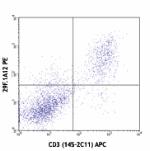
Con-A and IL-2 stimulated (3 days) C57BL/6 splenocytes stain... 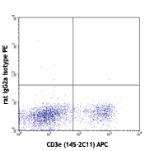
Con A stimulated (3 days) C57BL/6 splenocytes stained with r... -
Purified anti-mouse CD279 (PD-1)

Con A and IL-2 stimulated mouse splenocytes (day 3) were sta... 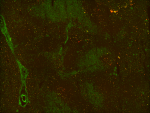
Fresh, frozen mouse spleen was stained with purified CD279 c... -
PerCP/Cyanine5.5 anti-mouse CD279 (PD-1)

Con-A and IL-2 stimulated C57BL/6 splenocytes (3 days) stain... -
APC anti-mouse CD279 (PD-1)
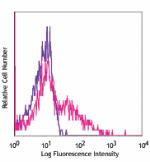
Con-A and IL-2 stimulated C57BL/6 splenocytes (3 days) stain... -
Biotin anti-mouse CD279 (PD-1)
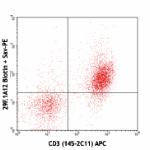
Con-A and IL-2 stimulated (3 days) C57BL/6 splenocytes stain... 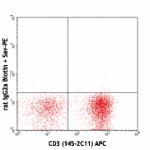
Con A-stimulated (3 days) C57BL/6 splenocytes stained with C... -
FITC anti-mouse CD279 (PD-1)
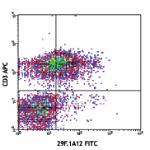
Con-A and IL-2 stimulated C57BL/6 mouse splenocytes (3 days)... 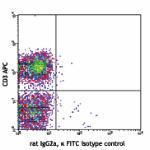
-
PE/Cyanine7 anti-mouse CD279 (PD-1)

Con-A and IL-2 stimulated (3 days) C57BL/6 mouse splenocytes... -
Brilliant Violet 421™ anti-mouse CD279 (PD-1)

Con-A and IL-2 stimulated C57BL/6 splenocytes (3 days) were ... 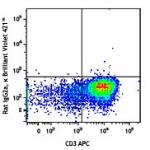

Mice were injected subcutaneously with sheep red blood cells... -
Brilliant Violet 605™ anti-mouse CD279 (PD-1)
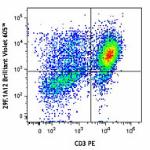
Con-A and IL-2 stimulated C57BL/6 splenocytes (3 days) were ... -
APC/Cyanine7 anti-mouse CD279 (PD-1)

Con-A and IL-2 stimulated splenocytes (3 days) were stained ... -
Brilliant Violet 785™ anti-mouse CD279 (PD-1)
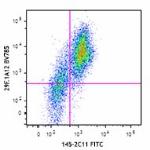
Con-A and IL-2 stimulated C57BL/6 splenocytes (3 days) were ... 
-
PE/Dazzle™ 594 anti-mouse CD279 (PD-1)
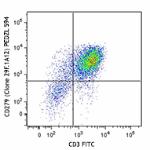
Con-A and IL-2 stimulated C57BL/6 splenocytes (three days) w... 
-
Alexa Fluor® 647 anti-mouse CD279 (PD-1)

Con A and IL-2 stimulated C57BL/6 splenocytes (three days) w... 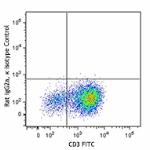
-
Brilliant Violet 711™ anti-mouse CD279 (PD-1)
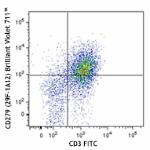
Con-A and IL-2 stimulated C57BL/6 splenocytes (three days) w... 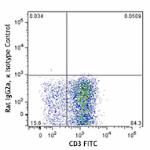
-
GoInVivo™ Purified anti-mouse CD279 (PD-1)
-
APC/Fire™ 750 anti-mouse CD279 (PD-1)
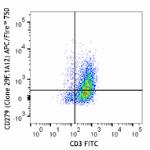
Con-A and IL-2 stimulated C57BL/6 mouse splenocytes (3 days)... 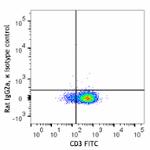
-
Brilliant Violet 510™ anti-mouse CD279 (PD-1)
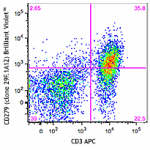
Con-A and IL-2 stimulated C57BL/6 mouse splenocytes (3 days)... 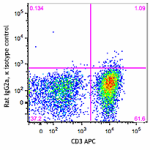
-
Ultra-LEAF™ Purified anti-mouse CD279 (PD-1)

Con A and IL-2 stimulated mouse splenocytes (day 3) were sta... -
APC/Fire™ 810 anti-mouse CD279 (PD-1) Antibody

Con-A and IL-2 stimulated C57BL/6 splenocytes (three days) w... -
PE/Fire™ 810 anti-mouse CD279 (PD-1) Antibody

Con-A and IL-2 stimulated C57BL/6 mouse splenocytes (three d... -
PE/Cyanine5 anti-mouse CD279 (PD-1)

Con-A and IL-2 stimulated C57BL/6 splenocytes (3 days) were ... -
PE/Fire™ 640 anti-mouse CD279 (PD-1)

C57BL/6 mouse splenocytes were stimulated with Con-A and IL-... -
Spark Red™ 718 anti-mouse CD279 (PD-1)

Con-A and IL-2 stimulated C57 splenocytes (3 days) were stai... -
PerCP/Fire™ 806 anti-mouse CD279 (PD-1)

Con-A and IL-2 stimulated C57BL/6 splenocytes (three days) w... -
Brilliant Violet 750™ anti-mouse CD279 (PD-1)

Con-A and IL-2 stimulated C57BL/6 splenocytes (3 days) stain... -
PerCP/Fire™ 780 anti-mouse CD279 (PD-1)

Con-A and IL-2 stimulated C57BL/6 splenocytes (three days) w... -
PE/Fire™ 700 anti-mouse CD279 (PD-1)

Unstimulated BALB/c splenocytes were stained with anti-mouse... 
Con A and IL-2 stimulated BALB/c splenocytes (three days) we... -
PE/Fire™ 744 anti-mouse CD279 (PD-1)

BALB/c mouse splenocytes were stained with anti-mouse CD3 (c... 
Con-A and IL-2 stimulated (3 days) BALB/c mouse splenocytes ... -
Brilliant Violet 650™ anti-mouse CD279 (PD-1)

Con-A and IL-2 stimulated C57BL/6 mouse splenocytes (3 days)... -
Spark Blue™ 574 anti-mouse CD279 (PD-1) (Flexi-Fluor™)
-
Spark PLUS B550™ anti-mouse CD279 (PD-1)

Con A+IL-2 stimulated BALB/c splenocytes (3 days) were stain...

 Login / Register
Login / Register 











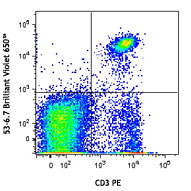
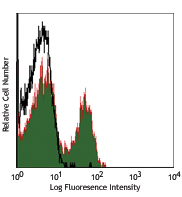
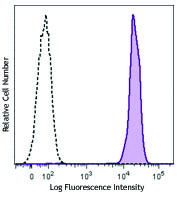




Follow Us